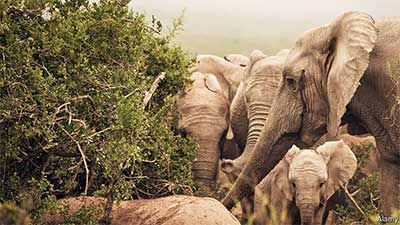Daily-current-affairs
/
12 Oct 2020
Elephant Reserve Deserve Legal Preserve: Daily Current Affairs for UPSC, IAS, UPPSC/UPPCS, BPSC, MPPSC, RPSC & All State PCS Examinations

Elephant Reserve Deserve Legal Preserve
IN NEWS
- The Union environment ministry has proposed an
amendment to the Wildlife Protection Act to protect
elephant reserves and corridors on the lines of those of
the tiger and sought responses of states to a proposed
Comprehensive National Elephant Action Plan (NEAP).
- There are 30 notified Elephant Reserves (ERs) in the
country spread over 15 states. Baitami (Odisha) and
Lemru (Chhattisgarh) are other ERs which are yet to be
notified by the state governments.
ABOUT
- Under the Wildlife Protection Act, state forest
departments have to prepare a tiger reserve management plan with an adequate number of forest
staff and strategies in place to protect the big cats. The law also gives legal status to the National
Tiger Conservation Authority, the regulatory body for around 50 tiger reserves in India.
- With the proposed amendment, the ministry proposes to have a similar legal framework for 30
elephant reserves across 15 states and statutory status for Project Elephant. India is home to about
30,000 elephants, or 60% of the global Asian elephant population.
WHY REQUIRED?
- Rising human-elephant conflict as elephants lose their traditional habitat and corridors are another
key issue of discussion with states for the national action plan. The aim is to put in place a
coordinated effort to reduce conflict through mitigation measures in elephant corridors.
- According to data shared with the Lok Sabha on September 23, close to 2,300 people were killed
by elephants in the past five years until 2019, which was 10 times the number killed by tigers.
Also, 400 elephants were killed by poachers or through poisoning by local residents.
- The Lok Sabha reply revealed that at least 433 people have been killed across West Bengal
between April 2014 and September 2019. In Odisha, Jharkhand and Chhattishgarh, the death toll
was 447, 391 and 329, respectively, during the period.
- Asian elephants are poached for their ivory tusks, but unlike their African cousins only male
Asian elephants have tusks. Every poaching event further skews the sex ratio which contrains
breeding rates for the species. Poaching rates are currently increasing because the Asian middle
class fuel demand despite the fact that there is a worldwide ban on ivory trade.
BRIEF OF PROJECT ELEPHANT AND RESERVE
- Project Elephant was launched in 1992 by the Government of India Ministry of Environment and
Forests to provide financial and technical support to wildlife management efforts by states for
their free-ranging populations of wild Asian Elephants.
- The project aims to ensure the long-term survival to the populations of elephants in their natural
habitats by protecting the elephants, their habitats and migration corridors. Other goals of Project
Elephant are supporting the research of the ecology and management of elephants, creating
awareness of conservation among local people, providing improved veterinary care for captive
elephants
- India’s first elephant reserve was created in Jharkhand in 2001 under Project Elephant. Spread
over 4,529 square kilometers area, the Singhbhum Elephant Reserve in Kolhan division, which
comprises three districts --east Singhbhum, west Singhbhum and Saraikela-Kharswan -- has
around 280 elephants, according to the 2017 elephant census.
- Reserves in the Western Ghats, Nilgiris and Eastern Ghats, spread across Karnataka, Kerala and
Tamil Nadu are collectively known as “Asia’s elephant empire”, with about 10,000 elephants.
ELEPHANT ON VARIOUS PROTECTION LIST
- The Government of India has declared Indian elephant as National Heritage Animal. Indian
elephant is also provided highest degree of legal protection by listing it in Schedule I of the
Wildlife (Protection) Act, 1972.
- Placing Indian elephant in Schedule I of the Convention on Migratory Species (CMS
Convention), will fulfil natural urge of migration of Indian elephant across India’s borders and
back safely and thereby promote conservation of this endangered species for our future
generations.
- Since 1986, the Asian elephant has been listed as Endangered on the IUCN Red List as the wild
population has declined by at least 50% since the 1930s to 1940s, i.e. three elephant generations.
The Asian elephant is threatened by habitat loss, degradation and fragmentation
WORLD ELEPHANT DAY: BRIEF BACKGROUND
- World Elephant Day is an annual global event celebrated across the world on August 12,
dedicated to the preservation and protection of elephants. The goal of
World Elephant Day is to create awareness about the plight of
elephants and to share knowledge and positive solutions for the better
care and management of captive and wild elephants.
RECONNECTING PROTECTED AREAS
- In the Terai Arc Landscape, which encompasses parts
of western Nepal and eastern India, WWF and its partners
are restoring degraded biological corridors so that elephants
can access their migratory routes without disturbing human
habitations. The long-term goal is to reconnect 12 protected
areas and encourage community-based action to mitigate
human-elephant conflict.
- WWF supports human-elephant conflict mitigation,
biodiversity conservation, and awareness-building among
local communities in two elephant habitats in the Eastern
Himalayas, the North Bank Landscape and the Kaziranga
Karbi-Anglong Landscape, and in the Nilgiris Eastern Ghats
Landscape in South India.
CONCLUSION
- The elephant plays a central role in Indian life and has done for many centuries.
Elephants are closely associated with religious and cultural heritage, playing an
important role in the country’s history. They remain revered today. An India without
elephants is simply unimaginable.
- Project Elephant has made a huge difference and provided a focus for conservation
effort. Although there are still many remaining problems, these efforts are beginning
to bear fruit regarding the conservation of India’s wild elephants.
- For further protection and conservation legal status is required and would play a
game changing role in environmental balance and in ecosystem.







